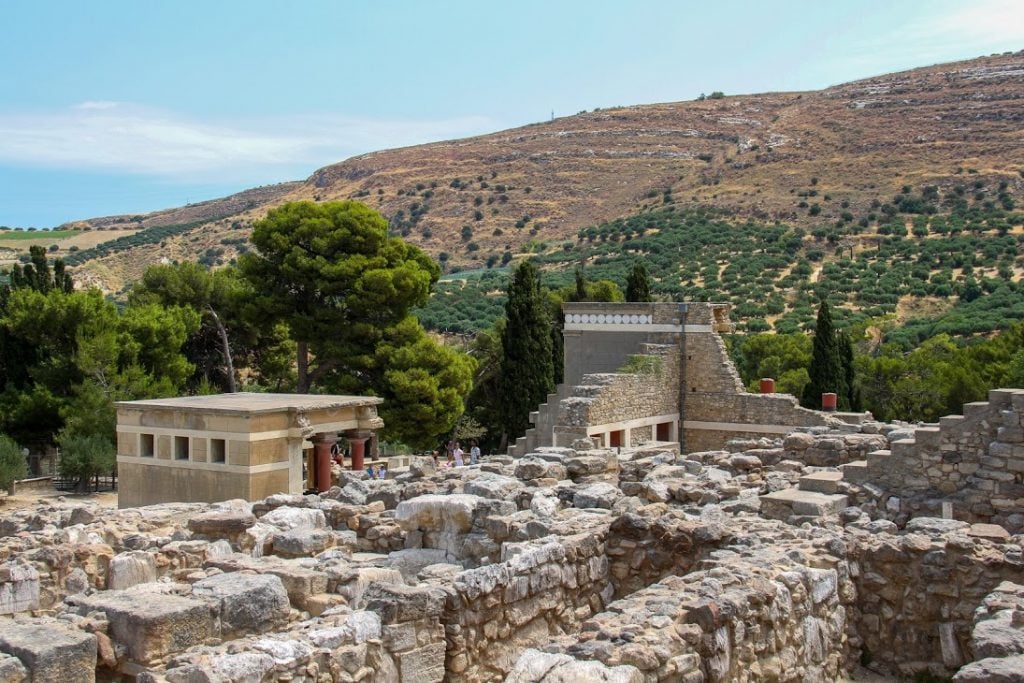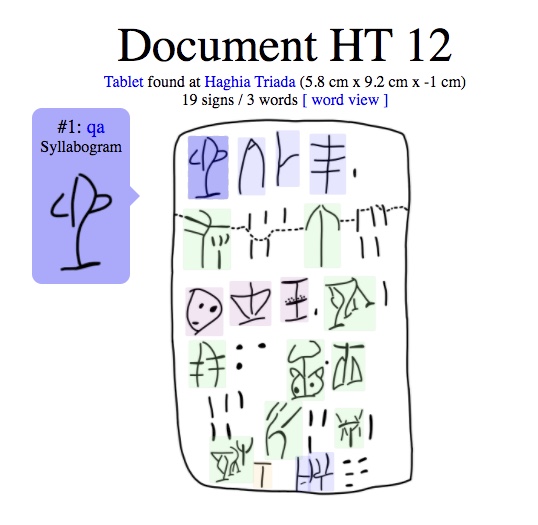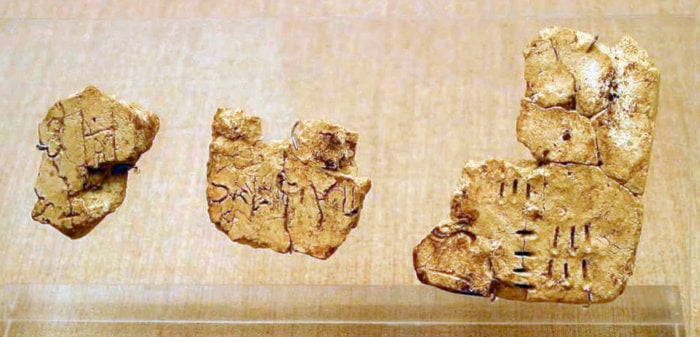
The Minoan language known as “Linear A” may finally be deciphered with the help of the internet which can be used to uncover previously-hidden links to the much-better understood Linear B language. Linear B developed later in the prehistoric period.
The puzzle of Linear A has tormented linguists for many decades, as they attempted to link it somehow to Linear B, which was translated successfully for the first time in the 1950s. Linear B was used on the Greek mainland and Crete 50-150 years later than Linear A.

Understanding the link between them and decoding the secrets of Linear A would allow experts to paint a much more complete picture of Minoan civilization going back as far as 1,800 BC.
Linear A, which was used by the Minoans during the Bronze Age, exists on at least 1,400 known inscriptions made on clay tablets. The language has baffled the world’s top archaeologists and linguistic experts for many years.

But thanks to the pioneering work of Dr. Ester Salgarella, a Junior Research Fellow in Classics at St John’s College, Cambridge, understanding the Minoans’ most ancient language, used during the period of their civilization’s highest flourishing, may be at hand.

Her research breakthrough, which has been hailed as “an extraordinary piece of detective work,” could provide the key for linguists to unlock the secrets of the Minoan language—and learn more about its society and culture. The linguist spoke about her groundbreaking research in an exclusive interview with Greek Reporter.
Dr. Salgarella explains that, perhaps most astonishingly, the internet itself may be the key that unlocks the link between the languages.

Thera eruption devastated Minoan civilization
The Minoans were a Bronze Age civilization based on Crete and other islands in the Aegean Sea. Named after the legendary King Minos, this lost civilization was one of Europe’s first urban societies.
Ruled from vast palaces, its people were accomplished artists and maritime traders, but their civilization fell into decline after a devastating volcanic eruption on the nearby island of Thera (modern-day Santorini).
Taking an interdisciplinary approach using evidence from linguistics, inscriptions, archaeology, and paleography (the study of the handwriting of ancient writing), Dr. Salgarella examined the two scripts.
To compare them more easily, she created an online resource of individual signs and inscriptions called “SigLA—The Signs of Linear A: A paleographic Database.” She explains: “At the moment there is a lot of confusion about Linear A. We don’t really know how many signs are to be taken as core signs; there’s even been a partial misclassification of signs in the past.”

“A foundation stone” to help unlock secrets of Minoan Linear A language
“This database tries to clear up the situation and give scholars a basis for advancement. We don’t have a Rosetta Stone to crack the code of Linear A, and more linguistic analysis is required, but this structural analysis is a foundation stone,” reveals Dr. Salgarella.
The discovery of the Rosetta Stone, which was inscribed with writing in both ancient Egyptian and Greek, allowed linguists to finally crack the code of Egyptian hieroglyphics in the 19th century.
The phonetic values of most Linear A syllabograms were already known from B, but the language expressed in Linear A has remained a mystery.

Linear A script carried over into Linear B
Around 1,600 BC, Linear A was borrowed from the Minoans by the Mycenaean Greeks and Linear B is the Greek Mycenaean dialect, used in administration of not only the Mycenaean palaces of Crete but also in Thebes, Myceanae, Pylos, and Tiryns on the Greek mainland.
Parallels between signs in Linear A and B have indeed been identified before, but Dr. Salgarella has now shown that a great many graphic variants of signs in the Minoan script were carried into Linear B. “This combined paleographical and structural examination—using sign typology and associations—has led me to revise the current script classification and to argue that these two scripts are actually two sides of the same coin,” said Dr. Salgarella.
Seh added that “most scholars have assumed that because the two languages are different the scripts must be distinct, but the relationship is more subtle than this.”
No writing at all for fifty years after fall of Minoan civilization
Following the fall of the Minoan civilization, there is a gap of about 50 years with no archaeological evidence of either script on Crete. Dr. Salgarella, who has revealed her findings in her newly published book, Aegean Linear Script(s): Rethinking the Relationship between Linear A and Linear B, explains “There is sufficient evidence that Linear B is a derivative from Linear A, so the question is, how did this transmission process happen?”
“I wanted to find out how we can account for the similarities and, more importantly, the differences, and fill in these gaps,” Dr. Salgarella says.
To form words, the scripts use “syllabaries,” meaning one written sign or symbol is not a single sound but an entire syllable. “Other signs are more like Chinese ideograms, or picture words,” says Dr. Salgarella.
Examining the patterns
Structural analysis involved looking at how the signs function, the direction in which they read, and whether they represent syllables, words, or punctuation. Composite signs fall into what the researcher calls ‘configurational categories.’
“I could see that there is some kind of rationale on how to put them together,” said Salgarella. By examining the patterns, she was able to come to a better understanding of how to read the composite signs and make sense of some of the combinations. The linguist hopes her findings will be a stepping stone to further research by linguists, paleographers, and archaeologists, all working together.
The Minoans used Linear A primarily, but not exclusively, for administrative purposes. Small clay ‘labels’ found on Crete bear short Minoan inscriptions on one side and imprints of fibers or string on the other. These suggest the labels were used to secure information written on folded or rolled perishable material, such as papyrus.
Clay tablets “baked” for eternity by fires from natural disasters
Natural disasters caused fires, which destroyed any writing materials—but very fortuitously “baked” the inscriptions into the clay labels and tablets. It’s possible, said Dr. Salgarella, that in the two generations between the periods when Linear A ended and Linear B appeared, writing may not have been used widely, but her findings show parts of the earlier script did actually survive and were adapted by the Greeks into Linear B.
“The two scripts (not the two languages) can be seen as two sides of the same coin, and that is the reason why I chose the title ‘Aegean Linear Script(s)’ for my book,” the linguistic explains. “The issue here is that the script—like the letters that are part of our alphabet, for example—has to be kept distinct from the linguistic level (language) although these two levels are of course interrelated.
“What we see with Linear A, Linear B, and the two different languages notated (Minoan and Greek) is that the graphic system (script) was continued without considerable change (but of course there are differences), but the languages differ. Upon the transmission process of Linear A to Linear B there was therefore ‘linguistic shift’. However, the graphic system was not deeply affected,” she says.
Asked by Greek Reporter if there are exact translations of any Linear A writing at present, Salgarella demurred, but explained why finding many corollary symbols leads to hope that it will indeed be completely understood one day.
“I am afraid there is currently no exact translation of the sign-sequences (= words) attested on Linear A tablets (as well as other document types). This is primarily because we have not yet identified the linguistic family the Minoan language belongs to (unless it has to be taken as an ‘isolated’ language),” she replies.
However, there are two reasons we can still get a general idea of the content of some tablets by comparison with Linear B.
Logograms, place names are important clues in discovering secrets of Minoan Linear A language
“Some logograms (picture-signs standing for commodities, e.g. ‘grain’, ‘figs’, ‘wine’, ‘olives’, ‘oil’) are the same in both Linear A and Linear B, meaning that these were continued from the Linear A script (and administrative system) onto the Linear B script (and administrative system),” said the linguist.
“So, if we know the meaning of any such logogram in Linear B, we can assume it may have been the same in Linear A. Now, if on a Linear A tablet we can see the logogram for ‘wine,’ at least we can get a general idea of the content of the record: ‘wine’ (it could have been a delivery of the product, an allocation or even wine to be used in specific ceremonial or religious contexts),” added Salgarella.
Additionally, she explained that “Most words occurring on Linear A tablets are understood to be personal names and place names. We do have a number of such names on Linear A tablets that are also found on Linear B tablets. For instance, in both LA and LB we have the place-name ‘pa-i-to’ (‘Phaistos’).”
“As to personal names, we have the following correspondences (at times showing morphological adaptation to the Greek language): LA ‘di-de-ru’ corresponds to LB ‘di-de-ro’, LA ‘qa-qa-ru’ to LB ‘qa-qa-ro’, LA ‘ka-sa-ru’ to LB ‘ka-sa-ro’, LA ‘pa-ja-re’ to LB ‘pa-ja-ro’ just to name a few,” said Salgarella, providing examples.
Many “core signs” shared between Minoan Linear A language and B
“So, if at present we cannot really ‘translate’ Linear A (as this would require knowledge of the underlying language), we are still able to read the texts if we apply to the Linear A signs that have got the same shape in Linear B (so-called ‘homomorphic’ signs) the same phonetic values that have been reconstructed for Linear B,” Salgarella explained.
“This process is not unproblematic and there is an ongoing debate as to the legitimacy of doing so, Salgarella admits. “However, if we assume that the phonetic values of the signs that are shared between the two scripts may have had a similar or comparable sound value, then we are able to at least ‘read’ Linear A inscriptions in phonetic transcription with an approximation.”
Salgarella’s research and new database identifies many vital “core signs.” Greek Reporter asked the linguist how many of these exist and what they stand for.
“By ‘core’ signs I mean those simple signs (i.e. single graphic units, not combinations of signs) that are attested on all the Linear A evidence so far unearthed at different sites on Crete and the Aegean islands. This set of ‘core signs’ also shows the most similarities with the Linear B signs,” reveals Salgarella.
“In fact, most of these core signs are shared between Linear A and Linear B, and are,” according to Salgarella, “therefore referred to with the prefix ‘AB’ (e.g. AB 01, AB 08 etc.) in the research.”
“There are a total of some 80 core signs,” Salgarella states. “In addition to core signs, in Linear A we also find ‘site-specific’ signs, meaning that they are only attested on the Linear A evidence found at a given site only. As a trend, we can see that these site-specific Linear A signs were not transmitted onto Linear B.
Open-access online database makes scholarship available to all
“This is the reason why,” explains Salgarella, “it is productive to differentiate between these two sets of signs (core and site-specific) to examine in detail the characteristics of both Linear A as well as the Linear A to Linear B transmission process.”
Salgarella also points to the research conducted by Professor John Younger (now Emeritus), who has transcribed Linear A texts which can be viewed here.
Other Linear A texts from other sites can be viewed here.
The open-access SigLA database of inscriptions was created in collaboration with computer scientist Dr. Simon Castellan, from the University of Rennes in France. It features a list of 300 standard signs and 400 inscriptions which were manually copied. It is still under construction, but more than 3,000 individual signs found within the inscriptions are currently searchable.
“An extraordinary piece of detective work”
Salgarella explains that “Collecting the Linear A inscriptions in a unified database is of paramount importance to be able to answer sophisticated paleographical and linguistic questions about the Linear A script as well as the Minoan language it encodes, which will help us reconstruct the socio-historical context of the Minoan civilization.”
Professor Tim Whitmarsh, the A.G. Leventis Professor of Greek Culture and Fellow of St. John’s, had high praise for Salgarella’s work and said that “cracking Linear B was a huge post-war triumph for Classics, but Linear A has remained elusive.”
“Dr. Salgarella has demonstrated that Linear B is closely related to its mysterious and previously illegible predecessor. She has brought us one step closer to understanding it. It’s an extraordinary piece of detective work,” praises Whitmarsh.
See all the latest news from Greece and the world at Greekreporter.com. Contact our newsroom to report an update or send your story, photos and videos. Follow GR on Google News and subscribe here to our daily email!



